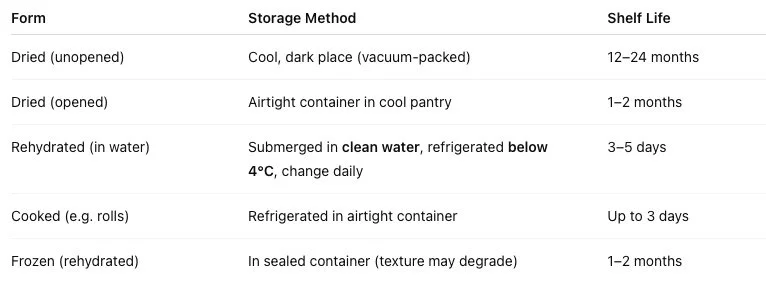How to Use Yuba Sheets for Crunchy Toppings, Wraps and Rolls
What Is Yuba — and Why It Deserves More Love
Yuba, often called tofu skin, forms when soy milk is gently simmered, and a thin protein film solidifies on the surface. This skin is lifted and dried — becoming what we know as dried yuba sheets (or sticks, knots, or bundles).
👉 Note: Yuba is not technically tofu — it’s made from the film of soy milk protein, not coagulated curds like traditional tofu.
Once rehydrated, yuba becomes supple and chewy, with the ability to crisp beautifully when cooked. While it doesn’t puff like pastry, its layered, golden textures bring flavour, structure, and artistry to the plant-based plate.
Why Cook with Yuba Sheets?
🌿 A minimally processed, whole-food soy product
🧧 Rooted in Chinese, Japanese, and Southeast Asian cuisines
🍽 Versatile textures: tender, chewy, crisp, or mock-meaty
🔥 Easily shaped — fold, wrap, roll, shred, or simmer
🧘 Celebrated in Buddhist temple cooking (shōjin ryōri) for its symbolism and simplicity
How to Rehydrate Yuba Sheets (Safely and Effectively)
⚠️ Note: This guide focuses on dried yuba sheets. Sticks, knots, and bundles require longer soaking times (see table below).
✨ Standard Soaking Method (with Baking Soda):
Soak in warm water (40–50°C) with ¼ tsp baking soda per litre
Soak for 10–15 minutes until flexible
Pat dry thoroughly before cooking or rolling
🧪 Why baking soda?
Baking soda raises the pH of the soaking water, weakening protein crosslinks and loosening surface fibres. This results in a more tender, pliable yuba.
⚠️ Use sparingly — excess can cause bitterness or an unpleasant soapy taste.
🕒 Rehydration Time by Yuba Form
❄️ Storage & Food Safety for Yuba
📦 Yuba Storage at a Glance
⚠️ Clostridium Botulinum – What You Must Know
Low-acid soy products like yuba can support the growth of Clostridium botulinum under anaerobic conditions (e.g. oil immersion or airtight storage at room temp).
Boiling for 10 minutes destroys the toxin, but not the heat-resistant spores.
Spores can become active and generate toxin again if yuba is stored improperly.
✅ Keep rehydrated yuba submerged in water below 4°C and change the water daily. This disrupts stagnant, low-oxygen conditions — a critical factor in preventing bacterial germination.
Three Transformative Techniques
1. Wrapped & Rolled — Spring Rolls and Stuffed Bundles
Yuba sheets make rich, pliable wrappers perfect for stuffing.
Fill with sautéed shiitake, tofu mince, noodles, or lentils
Roll burrito-style or fold like rice paper rolls
Slice into crosswise parcels for elegant plating
Cook:
Steam for supple rolls
Pan-fry seam-side down for a golden crust
Brush with soy sauce or sesame oil for colour and depth
2. Flaky Folds – For Golden, Layered Crispiness
Layered yuba develops a crisp-tender bite, especially around the edges.
How to do it:
Stack 3–4 rehydrated sheets, brushing lightly with oil
Fold into triangles, envelopes, or spring roll–like shapes
Stuff with tofu ricotta, spinach, mushrooms, or herbs
Cook:
Bake at 180°C (15–20 mins)
Air-fry for low-oil crispiness
Pan-fry both sides until blistered and golden
3. Crispy Shreds – For Garnishes and Toppers
Cut yuba into ribbons and roast until crackly — perfect for:
Noodle bowls and miso soup
Congee, salads, or tofu rice bowls
Sweet toppings (try maple-cinnamon)
Tips:
Start with very dry sheets — moisture prevents crisping
Toss with oil and optional seasoning
Bake or air-fry at 180°C until lightly golden
🔧 Common Yuba Troubleshooting
Too Tough or Chewy?
Use baking soda in a soak
Extend soaking time for denser pieces
Boil briefly post-soak if needed
Won’t Crisp?
Pat completely dry after soaking
Cook hotter (up to 200°C)
Use a light oil brushing or glaze
Tearing While Rolling?
Don’t oversoak
Use trimmed, manageable sheet sizes
Keep fillings compact and even
🧘 Shojin Ryori, Mottainai, and the Spirit of Yuba
Yuba plays a key role in shōjin ryōri, the Zen Buddhist culinary tradition based on mindfulness and non-violence.
Its creation — a fragile film lifted from soy milk — reflects the mottainai ethos: the reverent use of every part of an ingredient without waste.
In temple cooking, folding and simmering yuba is a spiritual act:
It teaches patience
Embodies stillness
Transforms the simplest ingredient into something sacred
🥣 Nutritional Snapshot: Small Sheet, Big Power
Yuba is a concentrated source of clean soy nutrition:
40–50g protein per 100g dried
Contains all 9 essential amino acids
Rich in iron, calcium, magnesium, zinc, and potassium
Provides omega-6 and monounsaturated fats from natural soy lipids
Naturally cholesterol-free and low in carbohydrates (varies by brand)
Soy isoflavones, found in yuba, have been associated with reduced risk of certain cancers in population studies, especially when replacing higher-fat animal proteins
✨ When eaten as part of a balanced, plant-forward diet, yuba can support long-term health — particularly when it replaces heavily processed or high-saturated fat meats.
Serving Ideas
Golden yuba spring rolls with hoisin dipping sauce
Crisp parcels of black garlic and tofu
Air-fried shreds over congee or miso broth
Teriyaki-glazed yuba strips in bánh mì
Cold sesame yuba salad with shredded cucumber
Sweet yuba crisps with cinnamon and maple
Final Takeaway: The Still Beauty of Golden Layers
Yuba is more than food — it’s a lesson in transformation.
A skin formed from patience. A fold crafted from care. A texture born from stillness.
With every roll and crisped corner, it reminds us that even the simplest ingredient — if honoured — can become extraordinary.



